471. The solution to the enigma seems to be a shift in time-frame from the
time of rongorongo to the time of Bharani. The
precession had moved the stars ahead in the Sun year
with *41.4 right ascension days since the time when
Bharani had been at 0h and we can from my tables
below see that Antares would at that ancient time
(approximately in the year 41.4 / 365.25 *
26000 - 1842 AD = 1105 BC) have risen heliacally
in "October 15 (288) = November 25 (329) - 41.
|
kotia
hia |
te kava tu |
kiore |
tu te ika |
te moko e te
hokohuki |
 |
 |
 |
 |
 |
|
Cb6-22 (137 = 529 - 392) |
Cb6-23 (615 - 85) |
Cb6-24 (223 - 84) |
Cb6-25 →
150 |
Cb6-26 |
|
Aug 31
ν Hydrae (163.1) |
Sept 1 (244)
no star listed (164 = 249 - 85)
ALTAIR
(α Aquilae)
|
2
Wings-27 (Snake)
η
Octans (165.4),
ALKES (Shallow Basin) =
α
Crateris
(165.6)
*124.0 = *165.4 - *41.4 |
3
ANA-TIPU-4 (Upper-side-pillar -
where the guards stood)
MERAK (Loin) = β Ursae Majoris
(166.2),
DUBHE (Bear) = α Ursae Majoris
(166.7) |
4
11h (167.4)
χ Leonis, χ¹ Hydrae (167.1), χ²
Hydrae (167.3) |
|
... Indeed, at the rituals of the
installation, the chief is invested
with the 'rule' or 'authority' (lewaa)
over the land, but the land itself
is not conveyed to him. The soil (qele)
is specifically identified with the
indigenous 'owners' (i taukei),
a bond that cannot be
abrogated. Hence the widespread
assertion that traditionally (or
before the Lands Commission) the
chiefly clan was landless, except
for what it had received in
provisional title from the native
owners, i.e., as marriage portion
from the original people or by
bequest as their sister's son ...
The ruling chief has no corner on
the means of production.
Accordingly, he cannot compel his
native subjects to servile tasks,
such as providing or cooking his
daily food, which are obligations
rather of his own household, his own
line, or of conquered people (nona
tamata ga, qali kaisi sara). Yet
even more dramatic conditions are
imposed on the sovereignity at the
time of the ruler's accession.
Hocart observes that the Fijian
chief is ritually reborn on this
occasion; that is, as a domestic
god. If so, someone must have killed
him as a dangerous outsider. He is
indeed killed by the indigenous
people at the very moment of his
consecration, by the offering of
kava that conveys the land to
his authority (lewaa). Grown
from the leprous body of a
sacrificed child of the native
people, the kava the chief
drinks poisons him ...
Sacred product of the people's
agriculture, the installation
kava is brought forth in Lau
by a representative of the native
owners (mataqali Taqalevu),
who proceeds to separate the main
root in no ordinary way but by the
violent thrusts of a sharp implement
(probably, in the old time, a
spear). Thus killed, the root (child
of the land) is then passed to young
men (warriors) of royal descent who,
under the direction of a priest of
the land, prepare and serve the
ruler's cup ... the tuu yaqona
or cupbearer on this occasion should
be a vasu i taukei e loma ni koro,
'sister´s son of the native owners
in the center of the
village'... Traditionally, remark,
the kava root was chewed to
make the infusion: The sacrificed
child of the people is cannibalized
by the young chiefs. The water of
the kava, however, has a
different symbolic provenance. The
classic Cakaudrove kava
chant, performed at the Lau
installation rites, refers to it as
sacred rain water from the heavens
... This male and chiefly water
(semen) in the womb of a kava
bowl whose feet are called 'breasts'
(sucu), and from the front of
which, tied to the upper part of an
inverted triangle, a sacred cord
stretches out toward the chief
... The cord is decorated with small
white cowries, not only a sign of
chieftainship but by name, buli
leka, a continuation of the
metaphor of birth - buli, 'to
form', refers in Fijian procreation
theory to the conceptual acception
of the male in the body of the
woman. The sacrificed child of the
people will thus give birth to the
chief. But only after the chief,
ferocious outside cannibal who
consumes the cannibalized victim,
has himself been sacrificed by it.
For when the ruler drinks the sacred
offering, he is in the state of
intoxication Fijians call 'dead
from' (mateni) or 'dead from
kava' (mate ni yaqona),
to recover from which is explicitly
'to live' (bula). This
accounts for the second cup the
chief is alone accorded, the cup of
fresh water. The god is immediately
revived, brought again to life - in
a transformed state ...
.jpg) |
From September 2 (245) when
at the epoch of rongorongo (assumed by me to
be at 1842 AD) the Sun was rising with Alkes (*165.6) to
"September 2 (245) when the Sun at the time
of Bharani had risen at *165.0 there should
be 572
- 531 = 41 glyphs (right ascension days):
|
37 |
e ha mata |
te hokohuki -
ma te maro |
te hokohuki ma
te maro |
ka ke te manu
ki te maro |
Te ariki |
hokohuki |
37 |
 |
 |
 |
 |
 |
 |
|
Cb8-8 (571) |
Cb8-9 |
Cb8-10 (392 + 181) |
Cb8-11 → 88 |
Cb8-12 |
Cb8-13 (184) |
|
Oct 12 (365 - 80)
HEZE = ζ Virginis
(205.0),
Southern Pinwheel Galaxy = M83
Hydrae
(205.7)
|
13
ε Centauri (206.3), κ Oct.
(206.4)
*165.0 = *206.4 - *41.4 |
14
no star listed (207) |
15 (288 = 16 * 18)
τ Bootis (208.2),
BENETNASH = η Ursae Majoris
(208.5), ν Centauri (208.7), μ
Centauri, υ Bootis (208.8) |
no star listed (209) |
MUPHRID = η Bootis
(210.1), ζ Centauri (210.3) |
... The name
[Benetnash] derives
from the Arabic phrase
meaning 'The leader of the
daughters of the bier'. The
daughters of the bier, i.e.
the mourning maidens, are
the three stars of the
handle of the Big Dipper,
Alkaid, Mizar,
and Alioth; while the
four stars of the bowl,
Megrez, Phecda,
Merak, and Dubhe,
are the bier ...
|
|
'Sept 15 |
16 |
17 (260 = 287 - 27) |
18 (9 * 29) |
19 |
20 |
|
"Sept 1 |
2 (245 = 286 - 41) |
"Sept 3 = Hora Nui 3 |
4
(13 * 19) |
5 |
6 (249 = 290 + 41) |
|
AUG 9 |
10 (222 = 286 - 64) |
11 |
(14 * 16 = 364 - 140) |
13 |
14 |
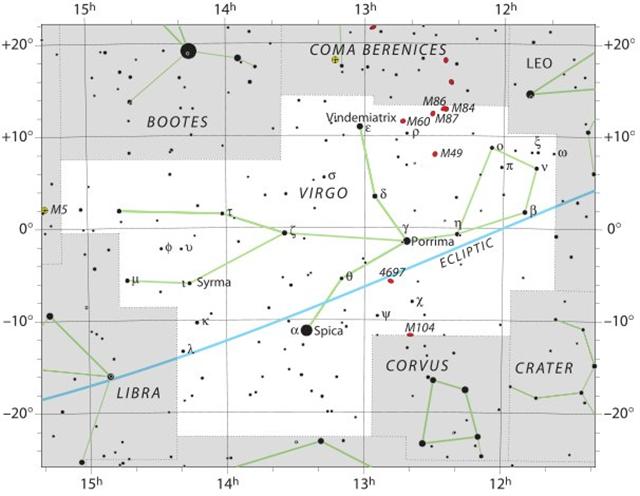
... When they
arrived at the place where
Hine nui lay asleep with her
legs apart and they could see
those flints that were set
between her thighs, Maui
said to his companions: 'Now, my
little friends, when you see me
crawl into the body of this old
chieftainess, whatever you do,
do not laugh. When I have passed
right through her and am coming
out of her mouth, then you can
laugh if you want to. But not
until then, whatever you do.'
His friends twittered and
fluttered about him and flew in
his way. 'O sir', they cried,
'you will be killed if you go in
there.' 'No', said Maui,
holding up his enchanted
jawbone. 'I shall not - unless
you spoil it. She is asleep now.
If you start laughing as soon as
I cross the threshold, you will
wake her up, and she will
certainly kill me at once. But
if you can keep quiet until I am
on the point of coming out, I
shall live and Hine nui
will die, and men will live
thereafter for as long as they
wish.' So his friends moved out
of his way. 'Go on in then,
brave Maui', they said,
'but do take care of yourself'.
Maui
at first assumed the form of a
kiore, or rat, to enter
the body of Hine. But
tataeko, the little
whitehead, said he would never
succeed in that form. So he took
the form of a toke, or
earth-worm. But tiwaiwaka
the fantail, who did not like
worms, was against this. So
Maui turned himself into a
moko huruhuru, a kind of
caterpillar that glistens. It
was agreed that this looked
best, and so Maui started
forth, with comical movements.
The little birds now did their
best to comply with Maui's
wish. They sat as still as they
could, and held their beaks shut
tight, and tried not to laugh.
But it was impossible. It was
the way Maui went in that
gave them the giggles, and in a
moment little tiwaiwaka
the fantail could no longer
contain himself. He laughed out
loud, with his merry, cheeky
note, and danced about with
delight, his tail flickering and
his beak snapping. Hine nui
awoke with a start. She realised
what was happening, and in a
moment it was all over with
Maui. By the way of rebirth
he met his end ....
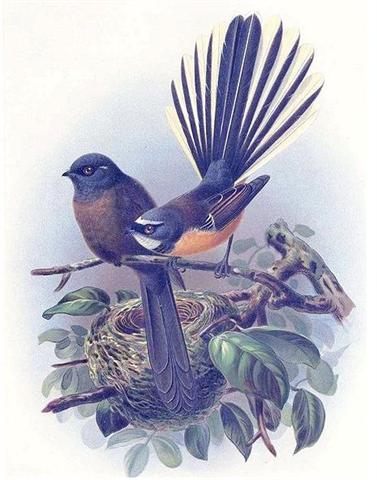 |
Also from October 15
(288 = 2 * 144 = 12 * 24) when the Sun rose
with Benetnash
(*208.5) to "October 15 (288) when the
Sun at the time of Bharani had risen
at
Antares (*249.1) there are 615 - 574 =
41 glyphs:
|
Te
inoino |
te
hau tea |
te
inoino |
tagata
honui
kua kake
- ki te
manu |
e
manu
piri rua |
|
Hau
=
Thread,
line,
string,
ribbon;
this is
the name
of the
fibres
of the
hauhau
tree
formerly
used to
make
twine,
cloth,
etc.;
hau kahi,
fishing
line for
tuna;
hau here,
line for
eel
trap;
hau
moroki,
strong,
tough
line,
thread;
hau
paka,
fibres
of the
hauhau
tree,
which
were
first
soaked
in
water,
then
dried to
produce
a strong
thread.
Ha'u
= Hat.
Vanaga.
Hat,
cord;
the tree
Triumfetta
semitriloba.
Van
Tilburg.
Ta.: The
tree
Hibiscus
tiliaceus.
Henry.
Hau.
1 a.
Hibiscus.
b. Wick.
P Pau.:
fau,
hibiscus.
Mgv.:
hau,
id. Mq.:
fau,
hau,
id. Ta.:
fau,
id. 2.
To
contribute.
Ta.:
aufau,
to pay,
to
contribute,
to
subscribe.
3. Hat,
cap,
helmet;
hakarere
ki te
hau,
to take
off the
hat.
Ta.:
fauurumaa,
war
bonnet.
4. Dew;
hakaritorito
ki te
hau,
to
bleach
in the
dew. P
Mgv.,
Mq.,Ta.:
hau,
dew. 5.
To blow
freshly,
coolness,
zephyr,
salubrious,
breeze,
wind (hahau,
ahau);
kona
hauhau,
kona
hahau,
a breezy
spot;
ahau ora,
agreeable
breeze;
hakahahau,
to hang
out in
the air;
hakaahau,
to blow.
T Mgv.:
hau,
to blow,
blusterous,
to
breathe.
Haua,
hoarse.
(Hauha);
araha
hauha,
to wait
for, to
look
forward
to.
Hauhau,
1. dog
(onomatopoetic).
2 a. To
scratch,
to
scrape,
to rub.
b. Wood
used in
plowing
fire. 3.
(hau
5).
Haumaru
(hau
5 -
marumaru)
cool,
cold.
Hauù,
to
replace.
Hauva,
twin,
cut T.
Hauvaero
(hau
3 -
vaero)
plume,
aigrette,
head
ornament.
Hauvarikapau
(hau
3 -
varikapau)
plume,
aigrette,
head
ornament.
Churchill.
Pau.:
Hau,
superior,
kingdom,
to rule.
Mgv.:
hau,
respect.
Ta.:
hau,
government.
Mq.:
hau,
id. Sa.:
sauā,
despotic.
Ma.:
hau,
superior.
Hauhau,
to
attack.
Ma.:
hau,
to chop.
Churchill.
Sa.:
fau,
to tie
together,
to
fasten
by
tying,
the tree
(Hibiscus
tiliaceus)
whose
bast is
used for
cord,
the kava
strainer
made
therefrom,
strings
in
various
uses;
fafau,
to lash
on, to
fasten
with
sennit;
faufau,
to
fasten
on, to
tie
together.
To.:
fau,
to
fasten
up the
hair,
the name
of the
hibiscus,
the kava
strainer
made
therefrom;
faufau,
to
fasten
the
outriggers
of small
canoes;
hau,
to
fasten
to;
fehauaki,
to tie.
Fu.:
fau,
the
hibiscus,
the kava
strainer;
faù,
fafaù,
faùfaù,
to
attach,
to tie.
Niuē:
fau,
fafau,
to make
by
tying.
Fotuna:
no-fausia,
to tie,
to
fasten.
Ta.:
fau,
the
hibiscus;
fafau,
to tie
together.
Pau.:
fau,
the
hibiscus.
Nuguria:
hau,
id. Ma.:
hau,
to bind,
to
fasten
together;
whau,
a shrub;
whauwhau,
to tie.
Ha.:
hau,
name of
a tree
with a
practicable
bark.
Mq.:
hau,
the
hibiscus.
Mgv.:
hau,
id.;
hahau,
to join
or tie
with
cords.
Nukuoro:
hau,
the
hibiscus,
a
garland.
Mg.:
au,
the
hibiscus.
Vi.:
vau,
the
hibiscus;
vautha,
to bind
together.
Churchill
2.
Tea.
1.
Light,
fair,
whitish.
2. To
rise (of
the
moon,
the
stars);
ku-tea-á
te
hetu'u
ahiahi,
the
evening
star has
risen.
Vanaga.
1. To
shine,
be
bright,
brilliant,
white;
tea
niho,
enamel
of the
teeth;
ata
tea,
dawn;
teatea,
white,
blond,
pale,
colorless,
invalid;
rauoho
teatea,
red
hair;
hakateatea,
to
blanch,
to
bleach.
P Pau.:
faatea,
to
clear,
to
brighten.
Mgv.:
tea,
white,
blanched,
pale.
Mq.:
tea,
white,
clear,
pure,
limpid.
Ta.:
tea,
white,
brilliant.
2.
Proud,
vain,
haughty,
arrogance,
to
boast;
tae
tea,
humble;
teatea,
arrogant,
bragging,
pompous,
ostentatious,
to
boast,
to show
off,
haughty;
hakateatea,
to show
off.
Mgv.:
akateatea,
pride,
vanity,
ostentatious,
to be
puffed
up. Ta.:
teoteo,
boastful,
proud,
haughty.
3. Mgv.:
teatea,
heavy
rain.
Ha.:
kea,
the rain
at
Hana
and
Koolau.
Churchill.
1.
White,
clear;
fair-complexioned
person,
often
favorites
at
court;
shiny,
white
mother-of-pearl
shell,
cfr.
keakea,
kekea,
Mauna
Kea.
Po'o
kea,
towhead,
gray-haired
person.
One
kea,
white
sand
(this is
shortened
to
ōkea
or
kea,
as in
the
expression
kea
pili mai,
drift
gravel -
vagabond).
(PPN
tea).
2.
Breast
milk.
See
Nu'a-kea.
3. A
variety
of sugar
cane,
among
Hawaiians
one of
the
best-known
and
most-used
canes,
especially
in
medicine:
clumps
erect,
dense,
of
medium
height;
pith
white.
Ua
ola ā 'ō
kō kea,
living
until
kea
cane
tassels
(until
the hair
turns
gray).
4. Name
listed
by
Hillebrand
for
kolomona
(Mezoneuron
kavaiense);
see
uhiuhi.
Wehewehe.
KEA.
adj.
Haw.,
also
keo,
keo-keo,
white,
lucid,
clear;
a-kea,
openly,
public;
au-akea,
at noon,
midday.
Sam.:
tea-tea-vale,
be pale;
ao-atea,
forenoon;
atea-tea,
wide,
spacious.
Tah.:
tea,
white;
teo-teo,
pride,
haughtiness;
atea,
clear,
distinct,
far off.
Marqu.,
tea,
atea,
white,
broad
daylight,
also
name of
the
principal
god;
light
generally,
as
opposed
to
darkness.
Fiji.,
cea-cea,
pale,
deathlike;
cecea,
daybreak,
light of
morning.
Malg.,
tziok,
brilliant,
snowwhite.
Ceram
(Mahai),
teen,
a star.
Greek,
θεος,
m.
θεα,
f. god,
goddess,
divinity
generally.
In
Greek,
θεος
signified
no god
in
particular,
but was
applied
ot
almost
all the
gods,
though
perhaps
more
often to
the sun.
As the
first
gods
were the
sun,
moon,
&c.,
their
brilliancy
and
whiteness
were the
underlying
sense of
the
names
given
them.
That
primary
sense
was
apparently
lost in
the
Greek
and the
other
West
Aryan
branches,
though
in the
Polynesian
both the
primary
and
derivative
sense
has been
preserved,
as in
the
Marqu.
atea,
both god
and
light,
in the
Tah.
tapu-tea,
the
rainbow,
and the
Sam.
tapu-i-tea,
the
evening
star ...
(Fornander) |
 |
 |
 |
 |
 |
|
Cb9-22
(222 =
614 -
392) |
Cb9-23 |
Cb9-24 |
Cb9-25
(225 = 9
* 25) |
Cb9-26 |
|
CLOSE TO
THE FULL
MOON: |
|
Nov 24
ρ
Ophiuchi
(248.1),
KAJAM
(Club) =
ω
Herculis
(248.3),
χ
Ophiuchi
(248.5),
SHE LOW
(Market
Tower) =
υ
Ophiuchi,
Tr.
Austr.
(248.7),
ζ Tr.
Austr.
(248.8) |
25 (329)
Al
Kalb-16
(The
Heart) /
Jyeshtha-18
(Eldest)
/
ANA-MUA-1
(Entrance
pillar)
ANTARES
= α
Scorpii
(249.1),
MARFIK
(Elbow)
= λ
Ophiuchi,
φ
Ophiuchi
(249.5),
ω
Ophiuchi
(249.8) |
26
(*250)
γ Apodis
(250.1),
σ
Herculis
(250.3),
θ Tr.
Austr.
(250.6),
τ
Scorpii
(250.7) |
27 (148
+ 183)
HAN = ζ
Ophiuchi
(251.0) |
28 (332
= 149 +
183)
ζ
Herculis,
η
Tr.
Austr.
(252.1),
η
Herculis,
β Apodis
(252.5) |
|
"Oct 14
(287 =
328 -
41) |
Tangaroa
Uri 15
(2 *
144) |
16 |
17 |
18 |
|
SEPT 21
(264 =
328 -
64) |
EQUINOX |
23 |
24 |
25 |
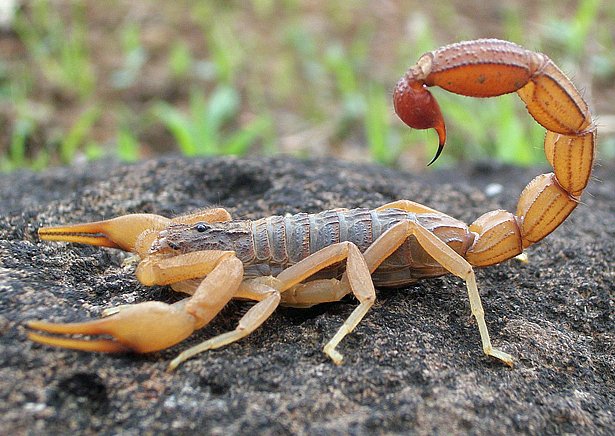 |
|
CLOSE TO
THE SUN: |
|
May 25
(290 /
2)
Net-19
(Crow)
AIN
(Eye) =
ε
Tauri,
θ¹
Tauri,
θ²
Tauri
(65.7) |
26
no star
listed
(66) |
27
no star
listed
(67) |
28 (148)
Rohini-4
(The Red
One) /
Pidnu-sha-Shame-4
(Furrow
of
Heaven)
/
ANA-MURI-2
(Rear
pillar -
at the
foot of
which
was the
place
for
tattooing)
ALDEBARAN
= α
Tauri
(68.2),
THEEMIN
= υ²
Eridani
(68.5) |
29
no star
listed
(69) |
|
MARCH 22
(145 -
64) |
23 |
24 |
JULIAN
EQUINOX
(84) |
26 |
 |
So when the 4 explorers
(not 6
because here the
Sun had reached
to one
of the square
corners of the
Earth) were waving leaves in
Tangaroa Uri
15 it meant
they had greeted
Hotu A Matua
in "October 15
(288) rather
than in October
15 (288).
Antares rose
anciently with the Sun in
Tangaroa Uri
15 and not in
October 15.
... The canoes
of Ava Rei
Pua and of
Hotu were
seen near the
(off-shore)
islets. On the
fifteenth day of
the month of
October (tangaroa
uri) the
canoe of Hotu
and the canoe of
Ava Rei Pua
landed. On the
fifteenth day of
the month of
October (tangaroa
uri),
Nonoma left
the house during
the night to
urinate outside.
At this point
Ira called
out to Nonoma,
'Look at the
canoe!'
Nonoma ran,
he quickly went
to Te Hikinga
Heru (a
ravine in the
side of the
crater Rano
Kau) and
looked
around. There he
saw the double
canoe way out
near the
(offshore)
islets, and the
two (hulls of
the canoe) were
lashed together.
He ran and
returned to the
front of the
house. He
arrived and
called into the
house: 'Hey you!
This canoe has
arrived during
the night
without our
noticing it!'
Ira asked
Nonoma,
'Where is the
canoe, which you
say is lying out
there (in the
water)?'
Nonoma's
voice came back:
'It is out there
(in the water)
close to the
(offshore)
islets! There it
lies, and the
two (hulls) are
lashed
together.' The
four of them
(corrected for
'the six of
them') went out
and picked up
leaves (on
branches) to
give signals.
They picked them
up, went and
arrived at Te
Hikinga and
saw the canoe.
Raparenga
got up, picked
up the leaves,
took them in his
hands, and
waved, waved,
waved, waved ...
(E:75)
This
interpretation
of the dates in
Manuscript E
implies the
double-canoe had
sailed away from
Hiva not
at Alkes
(*165.6) - where
the Sun rose in
September 2
(245) but 41
right ascension
days later, in
"September 2
(245) when at
the time of
Bharani the Sun
had risen
together with
the right
ascension line
leading down
from
κ Octantis
(*206.4 = *165.0
+ *41.4)
|
Egyptian
hand |
 |
Phoenician
kaph |
 |
Greek
kappa |
Κ (κ) |
|
Kaph
is
thought
to have
been
derived
from a
pictogram
of a
hand (in
both
modern
Arabic
and
modern
Hebrew,
kaph
means
palm/grip)
...
... The
manik,
with the
tzab,
or
serpent's
rattles
as
prefix,
runs
across
Madrid
tz. 22 ,
the
figures
in the
pictures
all
holding
the
rattle;
it runs
across
the
hunting
scenes
of
Madrid
tz. 61,
62, and
finally
appears
in all
four
clauses
of tz.
175, the
so-called
'baptism'
tzolkin.
It seems
impossible,
with all
this, to
avoid
assigning
the
value of
grasping
or
receiving.
But in
the
final
confirmation,
we have
the
direct
evidence
of the
signs
for East
and
West.
For the
East we
have the
glyph
Ahau-Kin,
the Lord
Sun, the
Lord of
Day; for
the West
we have
Manik-Kin,
exactly
corresponding
to the
term
Chikin,
the
biting
or
eating
of the
Sun,
seizing
it in
the
mouth.

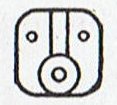

The
pictures
(from
Gates)
show
east,
north,
west,
and
south;
respectively
(the
lower
two
glyphs)
'Lord' (Ahau)
and
'grasp'
(Manik).
Manik
was the
7th day
sign of
the 20
and
Ahau
the last
... |
to ε
Centauri (*206.3
according to my
approximation).
|
Egyptian
jubilation |
 |
Phoenician
he |
 |
Greek
epsilon |
Ε
(ε) |
|
Wikipedia
points
at
the
Egyptian
gesture
with
arms
held
high
as a
Sign
of
jubilation,
which
may
have
been
the
origin
(via
Phoenician
he)
of
epsilon.

 |
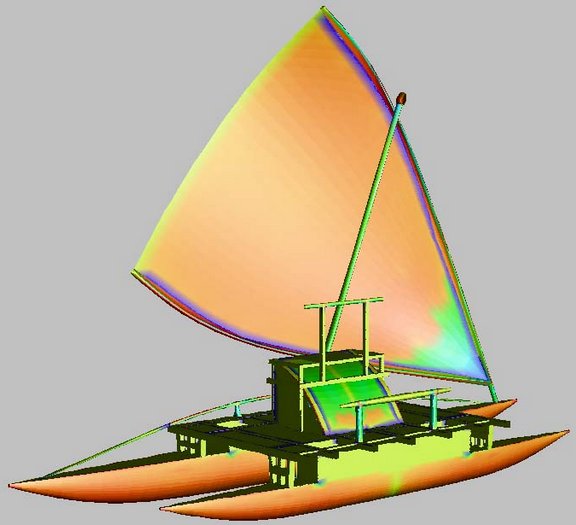
I
once upon a time
had discovered the
key role played
by Bharani from
studying the
manazil
structure of the
Arabs. This was
my perception of
the 1st half of
the year (before
Spica and Heze
arrived at the
beginning of the
2nd half):
|
Delta
(→
4) |
δ
Andromedae |
8.4 |
March
29
(88) |
0 |
|
|
Eta
(→
7)
|
η Phoenicis |
9.4 |
March 30 |
1 |
|
|
η Andromedae |
11.4 |
April 1 (91) |
3 |
|
|
Gamma (→ 3) |
Cih (Whip) (γ Cassiopeiai) |
12.4 |
April 2 (92) |
4 |
|
|
1 |
Al Sharatain |
Pair of Signs |
β Arietis (Sheratan), γ (Mesarthim) |
27.4 |
April 17 (107) |
19 |
|
|
Musca
Borealis |
35
(Head
of
the
Fly),
39
(Kaffaljidhma),
and
41
Arietis
(Bharani) |
41.4 |
May 1 (121) |
33 |
0 |
|
2 |
Al Dabarān |
Follower |
α Tauri (Aldebaran), θ¹, θ²´, γ (Hyadum I), δ (Hyadum II), ε (Ain) |
63.4 |
May 23 (143) |
55 |
22 |
|
3 |
Al Hak'ah |
White Spot |
λ
Orionis
(Heka),
φ¹,
φ² |
83.4 |
June 12 (163) |
75 |
42 |
|
4 |
Al Han'ah |
Brand |
γ Gemini (Alhena), μ (Tejat Posterior), ν,
η
(Tejat
Prior),
ξ
(Alzirr) |
93.4 |
June 22 (173) |
85 |
52 |
|
5 |
Al Dhirā' |
Forearm |
α Gemini (Castor), β (Pollux) |
113.4 |
July 12 (193) |
105 |
72 |
|
6 |
Al Nathrah |
Gap |
ε Cancri (Beehive) |
130.4 |
July 29 (210) |
123 |
90 |
|
7 |
Al Tarf |
End |
ξ
Cancri,
λ
Leonis
(Alterf) |
143.4 |
Aug 11 (223) |
135 |
102 |
|
8 |
Al Jabhah |
Forehead |
η Leonis (Al Jabhah), α (Regulus), ζ (Adhafera), γ (Algieba) |
152.4 |
Aug 20 (232) |
144 |
111 |
|
9 |
Al Zubrah |
Mane |
δ
Leonis
(Zosma),
θ
(Coxa) |
169.4 |
Sept 6 (249) |
161 |
128 |
|
10 |
Al Sarfah |
Turn |
β Leonis (Denebola) |
178.3 |
Sept 15 (258) |
170 |
137 |
|
11 |
Al Áwwā' |
Barker |
β (Alaraph), η (Zaniah), γ (Porrima), δ (Minelauva), ε Virginis (Vindemiatrix) |
191.5 |
Sept 28 (271) |
183 |
150 |
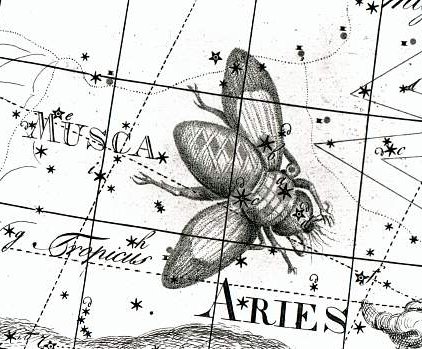
The
Explorers
had arrived
to Easter
Island in
Te Maro 1
and this
ought to
correspond
to "June 1
(152), which
was a
quarter (91
days) before
"August 31
(243, cfr
Cb6-22).
... On the
twenty-fifth
day of the
first month
(Vaitu
Nui),
Ira and
Makoi
set sail; on
the first
day of June
('Maro'),
the bow of
Ira's
canoe
appeared on
the distant
horizon,
came closer
and closer
on its
course, and
sailed
along, and
finally
(one) could
see the (new
home) land
...
(E:17)
We can
therefore
count 91 -
41 = 50
glyphs
backwards in
the C text
from koti
in Cb6-22
(137 = 529 -
392) to
glyph number
529 - 50 =
479:
|
manu
pao
i te
hau
tea
-
kua
tu |
manu
rere
ki
te
hau
tea
-
kua
tu |
manu
rere
ki
te
hau
tea |
kiore
-
henua |
|
Pao.
To
cut
off,
to
throw
a
lance.
Churchill.
Paopao,
spade,
shovel,
rubbish,
to
lacerate,
to
have
a
quarrel
with.
Churchill.
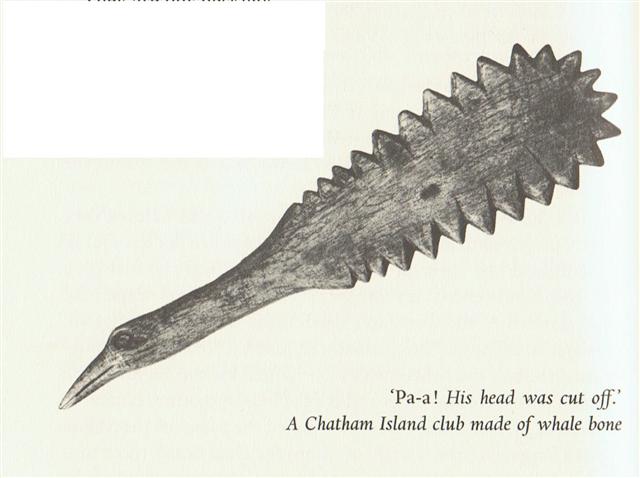 |
 |
 |
 |
 |
|
Cb4-13
→ 14
*
29½ |
Cb4-14
(477) |
Cb4-15 |
Cb4-16
(87
= 3
*
29) |
|
CLOSE TO
THE FULL
MOON: |
|
July
9
(190)
no
star
listed
(110) |
10
ALUDRA
(Virgin)
= η
Canis
Majoris
(111.1),
PROPUS
= ι
Gemini
(111.4),
GOMEISA
(Water-eyed)
= β
Canis
Minoris
(111.6)
*70.0 = *111.4 - *41.4 |
11
ρ Gemini (?) (112.1),
Eskimo
Nebula
=
NGC2392
Gemini
(112.2)
ANTARES
(α
Scorpii) |
12
(193
=
152
+
41)
Al
Dhirā'-5
(Forearm)
/
Punarvasu-7
/
Mash-mashu-Mahrū-10
(Western
One
of
the
Twins)
CASTOR
= α
Gemini
(113.4
=
41.4
+
72.0) |
|
"May
29
(190
-
41) |
30
(150) |
31 |
"June
1 =
Te
Maro
1 |
Evidently we
should look for
such stars
which have
the fraction
0.4 in order
to find
'pillars' in
the time-space
of Bharani.
Propus (ι
Gemini), for
instance,
was
located
exactly at
the right
ascension
líne for 70
days after
0h, viz. at
the back of
Castor, just
below the
center of his
head:

Furthermore,
the 25th day
of Vaitu
Nui
- when the
Explorers
had set sail
from Hiva
- should
correspond
to glyph
number 479
(Cb4-16) -
(152 - 115)
= 442.
... The
ancient
names of the
month were:
Tua haro,
Tehetu'upú,
Tarahao,
Vaitu nui,
Vaitu poru
[probably:
potu],
He Maro, He
Anakena,
Hora iti,
Hora nui,
Tagaroa uri,
Ko Ruti, Ko
Koró ...
| E vae ra - ka oho - ki te henua - kua huki |
ku kikiu - te henua |
|
Huki. 1. Pole attached to the poop from which the fishing-net is suspended: huki kupega. 2. Digging stick. 3. To set vertically, to stand (vt.). 4. Huki á te mahina, said of the new moon when both its horns have become visible. Vanaga. 1. To post up, to publish. 2. To cut the throat (uki). Mq.: Small sticks which close up the ridge of a house. Ha.: hui, the small uniting sticks in a thatched house. Churchill. Standing upright. Barthel. M. Spit for roasting. Te Huki, a constellation. Makemson. Hukihuki. 1. Colic. 2. To transpierce, a pricking. 3. To sink to the bottom. Churchill.
HUI¹, v. Haw., to unite together, to mix, to add one to another, to assemble, meet; s. cluster, collection of things; huihui, a bunch, cluster; huiuna (for huiana), a seam in a garment; la-hui, collection of people, a nation. Sa. sui, to dilute, to add ingredients to a thing; sui, to sew, to thread beads; susui, to mend, repair; susuia, to fasten the ridge-pole of a house. Tong., hui, mingle, mix, join; fufui, a flock of birds. N. Zeal., hui, huhui, to gather, mix, unite; ra-hui, a company; ka-hui, a herd, a flock. Tah., hui, a collection of persons, a company; hui-hui manu, flock of birds; hui-tara-wa, Orion's belt. Marqu., huhui, a bundle of taro. Sanskr., yu, to bind, join, mix; yuj, to join; yuga, a yoke, a pair, a couple; yûti, mixing; yûtha, flock of birds or beasts. Greek, ζευγνυμι, to join, put to, yoke up, bind, fasten; ζευγος, a yoke of beasts, pair, couple; ζυγον, the yoke; ζωνη, belt, girdle. Lat., jugum, a yoke; jugo, bind up, tie together; jungo, bind, join, unite. Goth., juk, a yoke. A.-Sax., geok, id. Scand., ok, id. Armen., zugel, attach together, yoke up; zoygkh, a couple, a pair. Pers., yûgh, a yoke. Irish, ughaim, harness. Welsh, jow, yoke. Lett., jûgs, yoke. Anc. Slav., jgo, yoke. Bohem., gho, id. Lith., jungas, id. A singular coincidence of application, if it has no nearer connection, by the Polynesian and the Latin of this word to similar purposes, occurs in the huhui and hui-tarawa of the former and jugulæ of the latter. In Hawaiian huhui designates a constellation generally, but especially that of the Pleiades; in Tahitian hui-tarawa, lit. the transverse or horizontal cluster, designates the stars generally called Orion's belt, and in Latin jugulæ represents the very same stars in the constellation Orion. HUI², v. Haw., to ache, be in pain; s. bodily pain; niho-hui, the toothache; hui, huihui, cold, chilly, as morning air or cold water; hukeki, hukiki, cold, shivering on account of wet. N. Zeal., huka, cold. Tah., hui, hui-hui, to throb as an artery, twitchings in the flesh. Sanskr., çuch¹, to be afflicted, grieve; çuch², to be wet, fetid; çuch, s., sorrow, grief; quære suçîma, cold? To this Sanskr. çuch Benfey refers the Goth. hiufau, to mourn, lament, and the O. H. Germ. huvo, an owl. (Fornander) |
 |
 |
| Cb3-1 (50 = 157 - 80 - 27) |
Cb3-2 (392 + 51 = 443) |
| June 6 (157 = 314 / 2) 5h (76.1)
ε Leporis (76.0), CURSA = β Eridani (76.4), λ Eridani (76.7) |
μ Aurigae, μ Leporis (77.6) |
| Vaitu Nui 25 (115) |
"April 26 |
|
... In view of the almost universal prevalence of the Pleiades year throughout the Polynesian area it is surprising to find that in the South Island and certain parts of the North Island of New Zealand and in the neighboring Chatham Islands, the year began with the new Moon after the yearly morning rising, not of the Pleiades, but of the star Rigel in Orion ... |

... From
the
natives
of South
Island
[of New
Zealand]
White
[John]
heard a
quaint
myth
which
concerns
the
calendar
and its
bearing
on the
sweet
potato
crop.
Whare-patari,
who is
credited
with
introducing
the year
of
twelve
months
into New
Zealand,
had a
staff
with
twelve
notches
on it.
He went
on a
visit to
some
people
called
Rua-roa
(Long
pit) who
were
famous
round
about
for
their
extensive
knowledge.
They
inquired
of
Whare
how many
months
the year
had
according
to his
reckoning.
He
showed
them the
staff
with its
twelve
notches,
one for
each
month.
They
replied:
'We are
in error
since we
have but
ten
months.
Are we
wrong in
lifting
our crop
of
kumara
(sweet
potato)
in the
eighth
month?'
Whare-patari
answered:
'You are
wrong.
Leave
them
until
the
tenth
month.
Know you
not that
there
are two
odd
feathers
in a
bird's
tail?
Likewise
there
are two
odd
months
in the
year.'
The
grateful
tribe of
Rua-roa
adopted
Whare's
advice
and
found
the
sweet
potato
crop
greatly
improved
as the
result.
We are
not told
what new
ideas he
acquired
from
these
people
of great
learning
in
exchange
for his
valuable
advice.
The
Maori
further
accounted
for the
twelve
months
by
calling
attention
to the
fact
that
there
are
twelve
feathers
in the
tail of
the
huia
bird and
twelve
in the
choker
or bunch
of white
feathers
which
adorns
the neck
of the
parson
bird
...
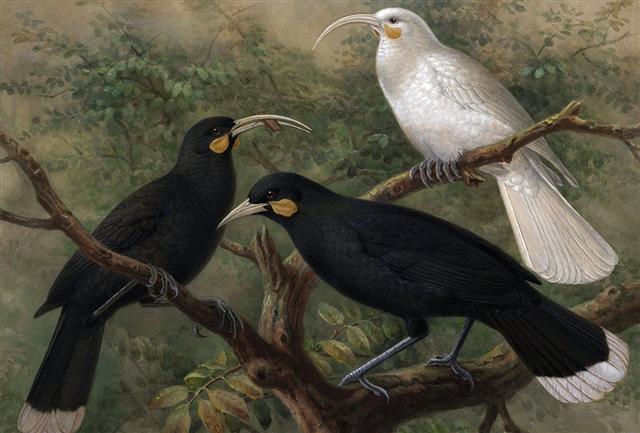
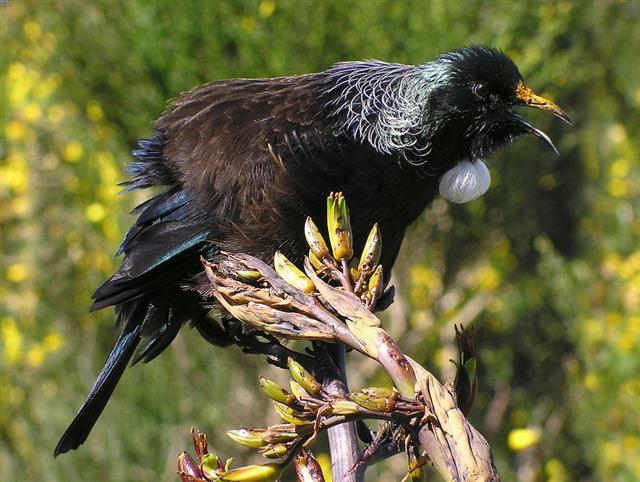
|


.jpg)






















